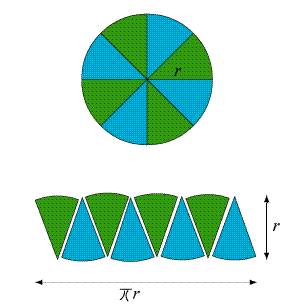 |
| Taken from Make It With Me |
Consider a simple cylinder of radius r and height h. These two lengths compose a square or rectangular slice from the center of the cylinder to its
And because we intend to find the volume of the whole cylinder, we replace the interval [a,b] with [0,2π] and rearrange to obtain:
 |
Polar graph of r=√(2π/θ) from Wolfram Alpha
|
Taking a Limit
Another idea related to the cylinder has to do with forming a rectangle from sectors of a circle by taking the limit of their length when stacked in an alternating pattern, rather like this:
 |
| Taken from the Victoria Department of Education |
This is by no means an uncommon way to think about the area of a circle, but I had never before seen anyone actually obtain the limit--it was always verbally inferred.
The method I use to articulate this limit expresses the chord length of each sector, and the number of sectors, in terms of the central angle θ. As the angle becomes smaller and smaller, the arc lengths will effectively come to equal the chord lengths. For each sector's chord length, we have:
Notice that each side of the sector stack is composed of 1/2 the total number of sectors. Hence, the length of all the chords on a side will be equal to
where n is the total number of sectors. Expressing n in terms of θ and rearranging, we obtain:
Then take the limit.
 |
| Limit of y=(2π/x) taken from Wolfram Alpha |
We now have a rectangle with sides πr and r, giving us an area πr2 equal to the area of the circle. We can use this to either multiply by the height h or solve the following integral:
Either way, it completes an interesting exploration of some important concepts in calculus.
[Errata]
* Thanks to Don "The Mathman" Cohen for the correction. I was thinking in terms of a unit circle, referring to the point to which the radius extends merely as "the radius." However, "circumference" far more effectively conveys my intent.
Wonderful. What is P? Don
ReplyDeleteP comes from the definition of a Riemann sum. It represents the partition of the interval [a,b]. ||P|| is the norm of the partition, the largest subinterval of [a,b] in P. Taking the limit of ||P|| forces all subintervals of [a,b] to approach zero.
ReplyDelete(1) Might find similar items to the circle-as-wedges here.
ReplyDeletehttp://www.its.caltech.edu/~mamikon/VisualCalc.html
(2) Always a pleasure to hear a word from Mathman Don Cohen (Hi Don).
Daniel Lichtblau
PS Anyone reading this who does NOT live in Champaign? If so, maybe tell us a bit about your weather...
I am very glad that you shared with us so many useful formulas. It is a very valuable article for me.
ReplyDeleteIt is here and it works - Easy Essay Writing & Grammar Checker can easily improve your English writing by transforming it correct, professional, and impressive. English writing is one of the most important forms of communication today, it is necessary to maintain it correct and professional. If you look for new ways that will help you to improve your writing skills... essay help
ReplyDeletehttps://saglamproxy.com
ReplyDeletemetin2 proxy
proxy satın al
knight online proxy
mobil proxy satın al
OVCXJ
Thanks for sharing your insights from the NCSA HPC Data Center Workshop—sounds like an incredible experience! It's exciting to see how data infrastructure is evolving to support future tech. For those exploring career paths that intersect with data and healthcare, here’s a useful resource on Medical Coding Courses in Delhi—a growing field where tech and healthcare meet in interesting ways.
ReplyDeleteMedical Coding Courses in Delhi